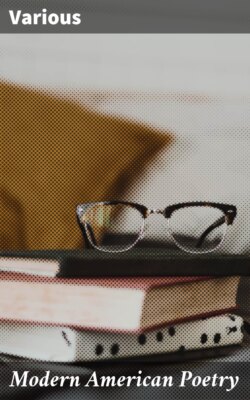Читать книгу Modern American Poetry - Various - Страница 13
На сайте Литреса книга снята с продажи.
SUMMARY—THE NEW SPIRIT
ОглавлениеTable of Contents
It is difficult to draw a line between periods, especially when one is called upon to define “modernity.” But in the case of the development of American poetry, the task is made easier by Whitman. Whitman ended and began an epoch. This collection therefore begins where he left off; it might well be called, “American Poetry Since Whitman.”
It would have been pleasant to divide the poetry itself into groups and distinct tendencies. Unfortunately such a scheme is impossible. In the first place, one can scarcely get a proper perspective on contemporary writers (on whom the chief emphasis has been placed), especially since many of them are still developing. Secondly, one cannot give the picture of a period in the state of flux except by showing its fluid character. The prime object of this collection is to reflect this very flux and diversity—particularly illustrated by those poets who, because of their strong individualism, would not fit in any one grouping. Since the chronological arrangement is, therefore, the most logical one, an arbitrary boundary has been fixed. The year 1830 becomes the dividing-line; any poet born earlier than that date is ruthlessly excluded. This, fortunately, eliminates scarcely any poet of value; for between Whitman (born 1819) and Emily Dickinson (that early imagist), there were no singers more memorable than the Cary sisters, Bayard Taylor and the painfully precise Richard Henry Stoddard.
It is a happy circumstance that this volume should begin with Emily Dickinson, whose work, posthumously printed, was unknown as late as 1890 and scarcely noticed until several years later. For here is a forerunner of the new spirit—free in expression, unhampered in choice of subject, penetrative in psychology—to which a countryful of writers has responded. No longer confined to one or two literary centers, the impulse to create is everywhere. There is scarcely a state, barely a township, that has not produced its laureate.
Most of the poets represented in these pages have found a fresh and vigorous material in a world of honest and often harsh reality. They respond to the spirit of their times; not only have their views changed, their vision has been widened to include things unknown to the poet of yesterday. They have learned to distinguish real beauty from mere prettiness; to wring loveliness out of squalor; to find wonder in neglected places; to search for hidden truths even in the dark caves of the unconscious.
And with the use of the material of everyday life, there has come a further simplification: the use of the language of everyday speech. The stilted and mouth-filling phrases have been practically discarded in favor of words that are part of our daily vocabulary. It would be hard at present to find a representative poet employing such awkward and outworn contractions as ’twixt, ’mongst, ope’; such evidences of poor padding as adown, did go, doth smile; such dull rubber-stamps (clichés is the French term) as heavenly blue, roseate glow, golden hope, girlish grace, gentle breeze, etc. The peradventures, forsooths and mayhaps have disappeared. … And, as the speech of the modern poet has grown less elaborate, so have the patterns that embody it. Not necessarily discarding rhyme, regular rhythm or any of the musical assets of the older poets, the forms have grown simpler; the intricate versification has given way to lines that reflect and suggest the tones of animated and even exalted speech. The result of this has been a great gain both in sincerity and intensity; it has enabled the poet of today to put greater emphasis on his emotion rather than on the shell that covers it—he can dwell with richer detail on the matter instead of the manner.
One could go into minute particulars concerning the growth of an American spirit in our literature and point out how many of the latter-day poets have responded to native forces larger than their backgrounds. Such a course would be endless and unprofitable. It is pertinent, however, to observe that, young as this nation is, it is already being supplied with the stuff of legends, ballads and even epics. The modern singer has turned to celebrate his own folk-tales. It is particularly interesting to observe how the figure of Lincoln has been treated by the best of our living poets. I have accordingly included seven poems by seven writers, each differing in manner, technique and point of view.
For the rest, I leave the casual reader, as well as the student, to discover the awakened vigor and energy in this, one of the few great poetic periods in native literature. With the realization that this brief gathering is not so much a summary as an introduction, it is hoped that, in spite of its limitations, this collection will draw the reader on to a closer consideration of the poets here included—even to those omitted. The purpose of such an anthology must always be to stimulate an interest rather than to satisfy a curiosity. Such, at least, is the hope and aim of one editor.
L. U.
January, 1921.
New York City.
MODERN AMERICAN POETRY
